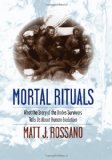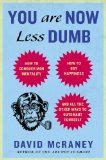August 14, 2013

Mortal Rituals: What the Story of the Andes Survivors Tells Us About Human Evolution by Matt J. Rossano (Columbia University Press, 2013)
(kindle ed.), (amazon.co.uk)
On December 21, 1972, sixteen young survivors of Uruguayan Air Force Flight 571 were rescued after spending ten weeks stranded at the crash site of their plane, high in the remote Andes Mountains. The incident made international headlines and spawned several best-selling books, fueled partly by the fact that the young men had resorted to cannibalism to survive.
Matt Rossano examines this story from an evolutionary perspective, weaving together findings and ideas from anthropology, psychology, religion, and cognitive science. During their ordeal, these young men broke “civilized” taboos to fend off starvation and abandoned “civilized” modes of thinking to maintain social unity and individual sanity. Through the power of ritual, the survivors were able to endure severe emotional and physical hardship. Rossano ties their story to our story, seeing in the mortal rituals of this struggle for survival a reflection of what it means to be human.
Google Books preview:
See also: Author’s Mortal Rituals blog at Psychology Today
Comments (0)
- cognitive science,culture,human evolution,new books
July 30, 2013

You Are Now Less Dumb: How to Conquer Mob Mentality, How to Buy Happiness, and All the Other Ways to Outsmart Yourself by David McRaney (Gotham, 2013)
(kindle ed.), (amazon.co.uk)
Book description from the publisher:
The author of the bestselling You Are Not So Smart shares more discoveries about self-delusion and irrational thinking, and gives readers a fighting chance at outsmarting their not-so-smart brains
David McRaney’s first book, You Are Not So Smart, evolved from his wildly popular blog of the same name. A mix of popular psychology and trivia, McRaney’s insights have struck a chord with thousands, and his blog—and now podcasts and videos—have become an Internet phenomenon.
Like You Are Not So Smart, You Are Now Less Dumb is grounded in the idea that we all believe ourselves to be objective observers of reality—except we’re not. But that’s okay, because our delusions keep us sane. Expanding on this premise, McRaney provides eye-opening analyses of fifteen more ways we fool ourselves every day, including:
- The Misattribution of Arousal (Environmental factors have a greater effect on our emotional arousal than the person right in front of us)
- Sunk Cost Fallacy (We will engage in something we don’t enjoy just to make the time or money already invested “worth it”)
- Deindividuation (Despite our best intentions, we practically disappear when subsumed by a mob mentality)
McRaney also reveals the true price of happiness, why Benjamin Franklin was such a badass, and how to avoid falling for our own lies. This smart and highly entertaining book will be wowing readers for years to come.
Google Books preview:
See also: Author’s blog (You Are Not So Smart)
Comments (0)
- cognitive science,new books,psychology
July 21, 2013

How Things Shape the Mind: A Theory of Material Engagement by Lambros Malafouris (MIT Press, 2013)
(amazon.co.uk)
Book description from the publisher:
An increasingly influential school of thought in cognitive science views the mind as embodied, extended, and distributed, rather than brain-bound, “all in the head.” This shift in perspective raises important questions about the relationship between cognition and material culture, posing major challenges for philosophy, cognitive science, archaeology, and anthropology. In How Things Shape the Mind, Lambros Malafouris proposes a cross-disciplinary analytical framework for investigating the different ways in which things have become cognitive extensions of the human body. Using a variety of examples and case studies, he considers how those ways might have changed from earliest prehistory to the present. Malafouris’s Material Engagement Theory adds materiality — the world of things, artifacts, and material signs — into the cognitive equation definitively. His account not only questions conventional intuitions about the boundaries and location of the human mind but also suggests that we rethink classical archaeological assumptions about human cognitive evolution.
Arguing that the understanding of human cognition is essentially interlocked with the study of the technical mediations that constitute the central nodes of a materially extended and distributed human mind, Malafouris offers a series of archaeological and anthropological case studies — from Stone Age tools to the modern potter’s wheel — to test his theory. How do things shape the mind? Considering the implications of the seemingly uniquely human predisposition to reconfigure our bodies and our senses by using tools and material culture, Malafouris adds a fresh perspective on a foundational issue in the study of human cognition.
See also: Author’s webpage
Comments (1)
- cognitive science,culture,new books
July 20, 2013

Feeling Beauty: The Neuroscience of Aesthetic Experience by G. Gabrielle Starr (MIT Press, 2013)
(amazon.co.uk)
Book description from the publisher:
In Feeling Beauty, G. Gabrielle Starr argues that understanding the neural underpinnings of aesthetic experience can reshape our conceptions of aesthetics and the arts. Drawing on the tools of both cognitive neuroscience and traditional humanist inquiry, Starr shows that neuroaesthetics offers a new model for understanding the dynamic and changing features of aesthetic life, the relationships among the arts, and how individual differences in aesthetic judgment shape the varieties of aesthetic experience.
Starr, a scholar of the humanities and a researcher in the neuroscience of aesthetics, proposes that aesthetic experience relies on a distributed neural architecture — a set of brain areas involved in emotion, perception, imagery, memory, and language. More important, it emerges from networked interactions, intricately connected and coordinated brain systems that together form a flexible architecture enabling us to develop new arts and to see the world around us differently. Focusing on the “sister arts” of poetry, painting, and music, Starr builds and tests a neural model of aesthetic experience valid across all the arts. Asking why works that address different senses using different means seem to produce the same set of feelings, she examines particular works of art in a range of media, including a poem by Keats, a painting by van Gogh, a sculpture by Bernini, and Beethoven’s Diabelli Variations. Starr’s innovative, interdisciplinary analysis is true to the complexities of both the physical instantiation of aesthetics and the realities of artistic representation.
See also: Author’s webpage (with links to publications)
Comments (0)
- cognitive science,culture,new books
July 17, 2013

Storytelling and the Sciences of Mind by David Herman (MIT Press, 2013)
(amazon.co.uk)
Book description from the publisher:
With Storytelling and the Science of Mind, David Herman proposes a cross-fertilization between the study of narrative and research on intelligent behavior. This cross-fertilization goes beyond the simple importing of ideas from the sciences of mind into scholarship on narrative and instead aims for convergence between work in narrative studies and research in the cognitive sciences. The book as a whole centers on two questions: How do people make sense of stories? And: How do people use stories to make sense of the world? Examining narratives from different periods and across multiple media and genres, Herman shows how traditions of narrative research can help shape ways of formulating and addressing questions about intelligent activity, and vice versa.
Using case studies that range from Robert Louis Stevenson’s Dr Jekyll and Mr Hyde to sequences from The Incredible Hulk comics to narratives told in everyday interaction, Herman considers storytelling both as a target for interpretation and as a resource for making sense of experience itself. In doing so, he puts ideas from narrative scholarship into dialogue with such fields as psycholinguistics, philosophy of mind, and cognitive, social, and ecological psychology. After exploring ways in which interpreters of stories can use textual cues to build narrative worlds, or storyworlds, Herman investigates how this process of narrative worldmaking in turn supports efforts to understand — and engage with — the conduct of persons, among other aspects of lived experience.
Comments (0)
- cognitive science,new books







